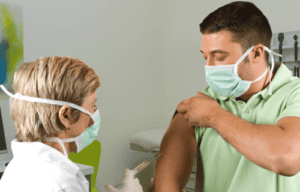
You can use a confirmed COVID-19 diagnosis even when a positive test is not documented. This is one of the many recent surprises in ICD-10-CM COVID-19 related coding guidelines.
With more patients coming into your office for screening, exposure and signs of COVID-19 and tests being in limited supply, you’ve got to nail down your ICD-10-CM coding. Here’s how to ensure your COVID-19 related ICD-10 codes will hold up to future audit scrutiny.
Report ICD-10 Code U.071 Only for Confirmed COVID-19 Cases
The CDC adopted the World Health Organization’s emergency creation of an ICD-10 code for confirmed diagnoses of COVID-19 cases: U07.1 (2019-nCoV acute respiratory disease). This code will be included in ICD-10-CM 2020.
You can make sure your usage holds up to scrutiny by looking for documentation of positive tests or provider confirmed diagnosis. Apply U07.1 when the documentation indicates one of the following confirmed criteria.
- CDC positive test: When documentation indicates that the CDC confirmed a test as positive, use1. However, you don’t necessarily have to wait for the federal test results to come back days or weeks later to use this code.
- Local/state test is positive: You should report code 1 for cases that are “presumed positive.” A patient is “presumed positive” when they have tested positive at the local or state levels, but the diagnosis has not yet been confirmed by the CDC.
- Asymptomatic, positive test: You should include asymptomatic patients who test positive as having a confirmed diagnosis.
- Provider indicates confirmed: “Confirmed” means that the provider has documented that COVID-19 is the diagnosis. The provider does not have to document the type of test used to reach that diagnosis.
For All Other COVID-19 Test Results, Look to Z Codes
Part of the reason that the CDC created the new COVID-19 codes is so that they can accurately track the virus. Therefore, you should not use U07.1 to report cases that are “suspect,” “possible,” “probable,” or inconclusive—basically anything but confirmed or presumed positive cases. In these situations, first code the signs or symptoms of the encounter (CDC guidelines give “fever” as an example, so R50.9). Other typical signs or symptoms include:
- R05 (Cough)
- 02 (Shortness of breath)
After the signs or symptoms diagnosis, use an additional ICD-10-code to describe the health status of the encounter:
- Exposure: When the provider documents a reason that he believes the patient has been exposed to the coronavirus, and the test results are unknown or negative, use code 828 (Contact with and [suspected] exposure to other viral communicable diseases).
- No exposure: If the provider has ruled out coronavirus exposure, use code 818 (Encounter for observation for suspected exposure to other biological agents ruled out).
Screening: For an asymptomatic person who has no known exposure to the virus, is being screened for COVID-19, and the test results are unknown or negative, use code Z11.59 (Encounter for screening for infectious and parasitic diseases, unspecified). Since the patient is asymptomatic, you would not have any signs or symptoms to report.
Sequencing: U07.1 Comes First; Pregnant Patients Are the Exception
When you report a COVID-19 confirmed diagnosis (U07.1) in addition to a manifestation, list code U07.1 first, followed by the manifestation ICD-10 codes. For instance, if the patient has confirmed COVID-19 and pneumonia bronchitis, you should report U07.1 as diagnosis 1 and J18.0 (Bronchopneumonia, unspecified organism) as diagnosis 2.
However, in pregnant patients, you’d code it a little differently. In that case, you’d first list a pregnancy complication diagnosis code (O98.5XXX, Other viral diseases complicating pregnancy, childbirth, and the puerperium). Then, you’d report code U07.1, followed by any additional codes for manifestations.
Additional codes for common COVID-19 manifestations include:
- 89 (Other viral pneumonia)
- 8 (Acute bronchitis due to other specified organisms)
- J22 (Unspecified acute lower respiratory infection)
- J40(Bronchitis, not specified as acute or chronic)
- J80 (Acute respiratory distress syndrome)
- 8(Other specified respiratory disorders)
Also, beware of exclusions. Do not report the following codes together with U07.1:
- B34.2 (Coronavirus infection, unspecified)
- B97.2 (Coronavirus as the cause of diseases classified elsewhere)
- J12.81 (Pneumonia due to SARS-associated coronavirus)
If you want more details on documentation requirements, allowed technology, and RHC/FQHC virtual codes that CMS now pays at higher rates through 2020, register for the online training “Get Paid $23/ea. for New Patient COVID-19 Testing With 99211” from coding and billing expert, Brenda Edwards, CPC, CDEO, CPB, CPMA, CPC-I, CEMC, CRC, CRCS, CMCS.
COVID-19 Resources For Accurate Coding
 |
 |
 |
||||||||
| . | ||||||||||
| Proven Preventive Medicine Coding Tactics During and After COVID-19 | Earn $110 For Patient Phone Call, New CMS Rule Applies | Use Time to Get Paid More for Your E/M Services | ||||||||
|
|
|
